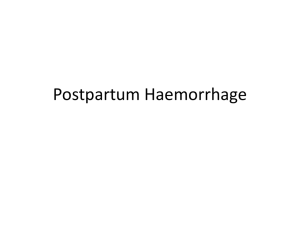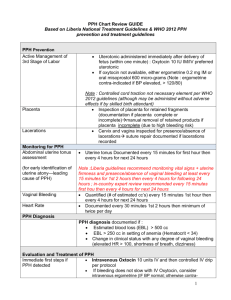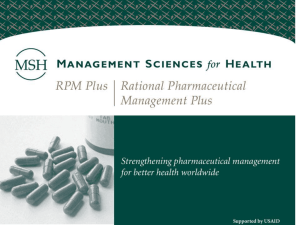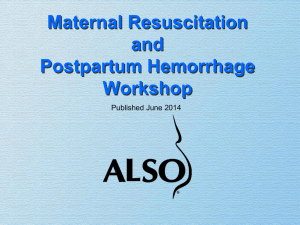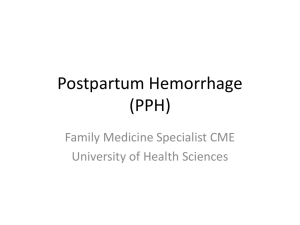Document 10302752
advertisement
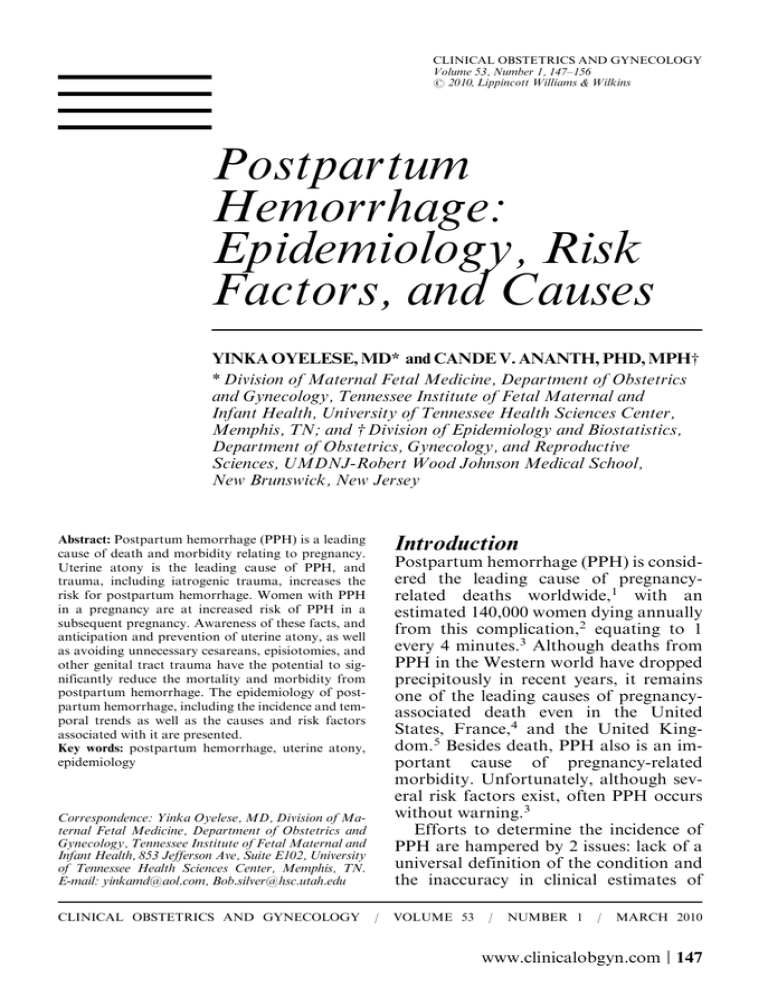
CLINICAL OBSTETRICS AND GYNECOLOGY Volume 53, Number 1, 147–156 r 2010, Lippincott Williams & Wilkins Postpartum Hemorrhage: Epidemiology, Risk Factors, and Causes YINKA OYELESE, MD* and CANDE V. ANANTH, PHD, MPHw * Division of Maternal Fetal Medicine, Department of Obstetrics and Gynecology, Tennessee Institute of Fetal Maternal and Infant Health, University of Tennessee Health Sciences Center, Memphis, TN; and w Division of Epidemiology and Biostatistics, Department of Obstetrics, Gynecology, and Reproductive Sciences, UMDNJ-Robert Wood Johnson Medical School, New Brunswick, New Jersey Abstract: Postpartum hemorrhage (PPH) is a leading cause of death and morbidity relating to pregnancy. Uterine atony is the leading cause of PPH, and trauma, including iatrogenic trauma, increases the risk for postpartum hemorrhage. Women with PPH in a pregnancy are at increased risk of PPH in a subsequent pregnancy. Awareness of these facts, and anticipation and prevention of uterine atony, as well as avoiding unnecessary cesareans, episiotomies, and other genital tract trauma have the potential to significantly reduce the mortality and morbidity from postpartum hemorrhage. The epidemiology of postpartum hemorrhage, including the incidence and temporal trends as well as the causes and risk factors associated with it are presented. Key words: postpartum hemorrhage, uterine atony, epidemiology Introduction Postpartum hemorrhage (PPH) is considered the leading cause of pregnancyrelated deaths worldwide,1 with an estimated 140,000 women dying annually from this complication,2 equating to 1 every 4 minutes.3 Although deaths from PPH in the Western world have dropped precipitously in recent years, it remains one of the leading causes of pregnancyassociated death even in the United States, France,4 and the United Kingdom.5 Besides death, PPH also is an important cause of pregnancy-related morbidity. Unfortunately, although several risk factors exist, often PPH occurs without warning.3 Efforts to determine the incidence of PPH are hampered by 2 issues: lack of a universal definition of the condition and the inaccuracy in clinical estimates of Correspondence: Yinka Oyelese, MD, Division of Maternal Fetal Medicine, Department of Obstetrics and Gynecology, Tennessee Institute of Fetal Maternal and Infant Health, 853 Jefferson Ave, Suite E102, University of Tennessee Health Sciences Center, Memphis, TN. E-mail: yinkamd@aol.com, Bob.silver@hsc.utah.edu CLINICAL OBSTETRICS AND GYNECOLOGY / VOLUME 53 / NUMBER 1 / MARCH 2010 www.clinicalobgyn.com | 147 148 Oyelese and Ananth blood loss at delivery.3,6–8 Furthermore, rates of PPH likely vary widely depending on practice patterns and both provider and patient characteristics. For instance, cesarean rates, which vary widely across regions, are likely to impact PPH rates. Traditionally, PPH has been defined as blood loss in excess of 500 mL after a vaginal birth, and over 1000 mL after a cesarean delivery. However, studies using chromate-tagged red blood cells have found that the average blood loss at vaginal delivery typically exceeds 500 mL.9,10 The American College of Obstetricians and Gynecologists have recommended that different criteria be used in the diagnosis of PPH.3 These include a hematocrit drop of greater than 10%, need for blood transfusion, and hemodynamic instability. Importantly, PPH may be early, occurring within 24 hours of delivery, or late, occurring after 24 hours of delivery, but before 6 weeks. The causes of early and late PPH are typically different. Incidence of PPH The incidence of PPH varies greatly depending on what criteria are used to define it. However, typical estimates been reported as about 4% to 6%.11,12 In an attempt to assess the global magnitude of PPH, Carroli and colleagues13 performed a systematic review of datasets from different regions around the world. They defined PPH as >500 mL blood loss, and severe PPH (SPPH) as >1000 mL of blood loss. After elimination of studies that used incorrect definitions of PPH, these authors, using 224 datasets, arrived at an overall prevalence of PPH (defined as blood loss in excess of 500 mL) of 6.09% [95% confidence interval (CI), 6.06-6.11]. However, when the blood loss was measured objectively, the rate was 10.6%. The rates were about one-half of this when the method of assessment was not specified, consistent with the previous www.clinicalobgyn.com observation that blood loss is typically underestimated. These authors also found the prevalence of SPPH (defined as blood loss >1000 mL) to be 1.86% (95% CI, 1.82-1.90). Again, the prevalence was almost doubled when the blood loss was measured objectively (3.04%; 95% CI, 2.90-3.17). Interestingly, these authors found that PPH was more common in rural than in urban settings. They also found that the rates of PPH were highest in Africa, and attributed this partly to a lack of adequately skilled delivery personnel. Magann and colleagues,11 in a study that defined PPH as blood loss in excess of 1000 mL, a need for transfusion, or hemodynamic instability, found that PPH occurred in 714 (5.2%) of 13,868 women who delivered vaginally. Combs and coworkers,12 in a case-control study of 9598 vaginal deliveries at Moffitt Hospital in San Francisco, found a rate of PPH (defined as a hematocrit drop of 10 points or more) of 2.8% (374 cases). These authors excluded patients from their study who had experienced antenatal bleeding during their pregnancies. In another study by the same authors,14 limited to women who underwent cesarean delivery, 196 of 3052 eligible deliveries were complicated by PPH, yielding a rate of 5.9%. In a prospective cohort study of 11,323 vaginal births in two Latin-American countries (Uruguay and Argentina), Sosa and coinvestigators15 found that mild PPH (defined as blood loss of >500 mL) complicated 10.8% of pregnancies. They also found that SPPH (>1000 mL of blood loss or need for transfusions) occurred in 1.9% of vaginal births. Importantly, blood loss was measured objectively in this study. Geller and coworkers,16 in a study of 1620 women from rural India with low-risk pregnancies, found that PPH occurred in 9.2% of women. However, the rate was 6.4% in those who received Postpartum Hemorrhage misoprostol in the third stage. In a population-based study of 307,415 women from Norway, Al-Zirqi and colleagues17 found that SPPH (defined as blood loss >1500 mL) complicated 1.1% of pregnancies. A population-based study of 3464 nulliparous women from the Netherlands18 found a much higher rate of PPH (defined as blood loss >500 mL) of 19%, whereas SPPH, defined as a blood loss in excess of 1500 mL, occurred in 4.2% of cases. Of note, the blood loss in this study was based on a visual estimate, weighing of used swabs, and measurement from a basin. In contradistinction to other studies, Sheiner and colleagues19 carried out a retrospective study of 154,311 pregnancies in the south of Israel, and found that PPH complicated only 666 (0.4%) of these. Fewer data exist regarding secondary or late PPH, which occurs >24 hours after delivery. However, a retrospective study by Hoveyda and MacKenzie20 of 132 consecutive cases of secondary PPH estimated that this complication occurred after 1% of deliveries. Temporal Trends in Rates of PPH Despite the scant literature on studies reporting trends in PPH, there is some evidence of an increasing trend in rates of PPH based on studies from both Australia and Canada.21–23 Ford et al22 found an increase in the rate of PPH from 4.7% to 6.1% between 1994 and 2002 in over 750,000 women. Cameron and colleagues21 carried out a population-based study in New South Wales, Australia, and found that the rate of PPH increased from 8.3% of deliveries in 1994 to 10.7% of deliveries in 2002. They also found a 6fold increase in maternal transfusions for PPH over the same period. Joseph and colleagues23 performed a retrospective cohort study examining 149 rates of PPH in Canada between 1991 and 2004. They observed an increase in rates of PPH from 4.1% to 5.1% (a relative increase of 23%), over that period. They also found that rates of hysterectomy associated with PPH increased 73% over the same period. Interestingly, they concluded that this increase in PPH was mediated by an increase in uterine atony over the period, which was present even after adjustment for temporal changes for risk factors for atony. Recurrence of PPH Prior PPH is an important risk factor for PPH. In a population-based study from Australia, Ford and colleagues24 used longitudinally linked hospital discharge and birth records to study the occurrence and recurrence of PPH in 125,295 women. They found that 5.8% of women had a PPH in their first pregnancy. They also found that the rate of a PPH in a second consecutive pregnancy (in those women who had a PPH in their first pregnancy) was 14.8%. Thus, there was a 3-fold increased risk of PPH in a second pregnancy (relative risk, 3.3; 95% CI, 3.1-3.5). Women who had PPHs in both their first 2 consecutive pregnancies had a 21.7% rate of PPH in their third consecutive pregnancy. Women who had PPH in a first pregnancy followed by a second pregnancy without a PPH still had an increased rate of PPH in their third pregnancy (10.2%). Thus, women with PPH in a pregnancy are at increased risk of PPH in a subsequent pregnancy. Causes and Risk Factors for PPH In understanding the causes and risk factors for PPH, it is important first to be aware of the physiologic processes that prevent excessive bleeding after delivery. The most common origin of bleeding after www.clinicalobgyn.com 150 Oyelese and Ananth delivery is the placental implantation site. The chief method by which bleeding is arrested is uterine myometrial contraction. Myometrial muscle fibers run in different directions, and when the uterus contracts, there is compression and occlusion of the large vessels that run between them. Thus, the primary mechanism by which excessive bleeding is prevented is uterine contraction; PPH ensues after a failure of this mechanism. A secondary mechanism of prevention of PPH is clot formation. However, as uterine contraction is the primary preventive mechanism, PPH is rare when the uterus is well contracted, even when there is a coagulation defect. Conversely, PPH will occur in the presence of uterine atony, even in the presence of a normal maternal coagulation system. Pregnancy is a hypercoagulable state, primarily to prevent massive hemorrhage after delivery. Defects in the coagulation pathway may also result in PPH, but this hemorrhage is frequently delayed. Causes of PPH The causes of PPH can be classified into 6 main groups (Table 1): UTERINE ATONY By far the most common cause of PPH is failure of adequate uterine contraction, or uterine atony. It has been estimated that this is the cause of over 70% of cases of PPH. Uterine atony can frequently be anticipated if one is aware of risk factors. Uterine overdistension, such as that caused by polyhydramnios, multifetal gestations, or fetal macrosomia may lead to uterine atony, and consequently PPH. Labor that is either very rapid or prolonged may lead to uterine atony. It is thought that rapid labor is associated with vigorous contractions, which tire out the uterus, whereas prolonged labor may lead to uterine exhaustion, or may be the result of inadequate uterine contractions, which www.clinicalobgyn.com TABLE 1. Causes of Postpartum Hemorrhage Uterine atony Labor-related causes: Induction of labor Oxytocin use Precipitous labor Prolonged labor Chorioamnionitis Uterine overdistension Multiple pregnancies Polyhydramnios Placental abruption with large intrauterine clot Fetal macrosomia Anesthesia General anesthesia with inhaled agents Genital tract trauma Iatrogenic Cesarean delivery Forceps delivery Vacuum delivery Episiotomy Spontaneous Genital tract lacerations Uterine rupture Retained placenta and clots Coagulation disorders Disseminated intravascular coagulopathy Placental abruption Liver dysfunction Amniotic fluid embolism Intrauterine fetal demise Thrombocytopenia Inherited bleeding dysfunction, eg, von Willebrand disease Anticoagulant therapy Uterine inversion Implantation of the placenta into the lower uterine segment Placenta previa Placenta accreta in turn causes postpartum uterine atony. Induced or augmented labor may also result in atony—all contributing to an occurrence of PPH. GENITAL TRACT TRAUMA Generally, if PPH is not due to uterine atony, genital tract trauma is likely the cause of the excessive bleeding. Trauma may result from lacerations of the perineum or cervix, episiotomy, or from uterine rupture. Factors that predispose to Postpartum Hemorrhage 151 RETAINED PLACENTA AND CLOTS largely ineffective. In cases of placenta accreta, the placenta actually invades the myometrium. There is no plane of cleavage at which the placenta can be separated. Thus, attempts at placental separation lead to tearing of the placenta. The remaining placental fragments and open sinuses typically lead to heavy hemorrhage. Retained placental fragments prevent adequate uterine contraction, and thus will lead to uterine atony and PPH. Epidemiology of PPH any of these will increase the risk of PPH. This includes both spontaneous and iatrogenic trauma. Cesarean delivery increases blood loss at delivery and thus is a cause of PPH. Instrumental delivery, whether by vacuum or forceps, also increases the risk of PPH. INHERITED OR ACQUIRED COAGULATION DEFECTS Disseminated intravascular coagulopathy, such as that associated with placental abruption, intrauterine fetal demise with prolonged retention of a dead fetus, massive blood loss or massive transfusion, amniotic fluid embolism, and sepsis, may lead to PPH. Other disorders of coagulation such as von Willebrand disease, thrombocytopenia, and anticoagulant therapy also are associated with excessive blood loss postpartum. UTERINE INVERSION Several studies have evaluated the epidemiology and risk factors for PPH. Traditionally cited risk factors include the factors that would lead to any of the causes listed above. The risks for PPH with some obstetric factors are shown in Figures 1 to 4. Combs and colleagues12 performed a case-control study in San Francisco, comparing 374 cases of PPH (defined as a drop in hematocrit of 10% or greater or need for transfusion) in vaginal delivery with 1122 matched controls. Risk factors for PPH included a prolonged third stage of labor [adjusted odds ratio (OR), 7.6; 95% CI, 4.2-13.5], preeclampsia (adjusted This is a rare but important cause of PPH and shock. This typically occurs secondary to strong traction on the cord before placental separation. The bleeding is probably because the uterus obviously cannot contract and compress the blood vessels. Shock is often disproportionate to the observed amount of blood loss. Nonetheless, this cause of PPH, if not recognized and treated appropriately, can become life-threatening. PLACENTA PREVIA AND PLACENTA ACCRETA In cases of implantation of the placenta into the lower uterine segment, PPH is more likely. This is because the lower uterine segment is only weakly contractile, and hence the primary mechanism of preventing blood loss from the placental implantation site (uterine contraction) is FIGURE 1. Risk of postpartum hemorrhage with labor induction. www.clinicalobgyn.com 152 Oyelese and Ananth FIGURE 2. Risk of postpartum hemorrhage with fetal macrosomia. OR, 5.0; 95% CI, 3.0-8.5), episiotomy (adjusted OR, 4.7; 95% CI, 2.6-8.4), previous PPH (adjusted OR, 3.6; 95% CI, 1.2-10.2), and twin gestation (adjusted OR, 3.3; 95% CI, 1.0-10.6). Other risk FIGURE 3. Risk of postpartum hemorrhage with prolonged third stage/retained placenta. www.clinicalobgyn.com FIGURE 4. Risk of postpartum hemorrhage with perineal trauma. factors included arrest of descent, lacerations, forceps/vacuum delivery, nulliparity, Asian race, and augmented labor. A population-based study in the Netherlands18 of nulliparous women found that risk factors for PPH (blood loss >500 mL) included a prolonged third stage (OR, 2.61; 95% CI, 1.83-3.72) and retained placenta (OR, 7.83; 95% CI, 3.78-16.22). Other significant risk factors, though less strongly associated with PPH were fetal macrosomia (OR, 2.11; 95% CI, 1.62-2.76), episiotomy (OR, 2.18; 95% CI, 1.68-2.81), and perineal laceration (OR, 1.40; 95% CI, 1.04-1.87). Magann and coworkers,11 in a study of PPH from the King Edward Memorial Hospital in Perth, Australia, found the following to be risk factors for PPH (defined as blood loss >1000 mL or need for transfusion): prior PPH, Asian race, antepartum hemorrhage, genital tract lacerations, macrosomia, labor induction, stillbirth, prolonged labor, chorioamnionitis, history of retained placenta, epidural anesthesia, and forceps after a failed vacuum. Postpartum Hemorrhage In a prospective cohort study, where PPH was defined as blood loss of 1000 mL or greater, Magann and colleagues25 found that the risk of PPH increased with the length of the third stage of labor. These investigators found that after 30 minutes, the odds of PPH were 6 times higher than less than 30 minutes. There was an increased risk of PPH at 10 minutes (OR, 2.1; 95% CI, 1.6-2.6), at 20 minutes (OR, 4.3; 95% CI, 3.3-5.5), and at 30 minutes (OR, 6.2; 95% CI, 4.6-8.2). Using receiver operating characteristic curves, the best predictor for PPH was a third stage of 18 minutes. In a study from Israel, Sheiner et al19 found, using multivariable analysis, that risk factors for PPH, included retained placenta (OR, 3.5; 95% CI, 2.1-5.8), failure to progress in the second stage (OR, 3.4; 95% CI, 2.4-4.7), placenta accreta (OR, 3.3; 95% CI, 1.7-6.4), and lacerations (OR, 2.4; 95% CI, 2.0-2.8). Other risk factors were instrumental delivery, a large-for-gestational-age fetus, and augmentation of labor with oxytocin. In a prospective cohort study from Latin America, Sosa et al15 found that retained placenta (OR, 6.0; 95% CI, 3.510.4), macrosomia (OR, 2.4; 95% CI, 1.92.9), multiple pregnancy (OR, 4.7; 95% CI, 2.4-9.1), episiotomy (OR, 1.7; 95% CI, 1.2-2.5), and need for perineal suture (OR, 1.7; 95% CI, 1.1-2.5) were risk factors for PPH (defined as blood loss >500 mL). All were also risk factors for SPPH (blood loss >1000 mL), as was induction of labor. These authors also found that several factors reduced the risk for PPH. These included active management of the third stage of labor (OR, 0.54; 95% CI, 0.39-0.75), multiparity (OR, 0.75; 95% CI, 0.60-0.93), and low birth weight (OR, 0.48; 95% CI, 0.36-0.64). Brinsden and Clark26 reviewed labor records of 1000 consecutive deliveries and found the incidence of PPH to be higher among those who underwent labor induction. When they did a further analysis 153 among primiparous women with normal deliveries, they found that the rate of PPH was almost double in those who underwent labor induction. In a study from Nigeria, Selo-Ojeme and Okonofua27 found that risk factors for PPH included a prolonged second stage and nonuse of oxytocins in the third stage. Several studies that have examined the use of oxytocin or other uterine contracting agents in the third stage, also called active management of the third stage, have found that these lead to a significant reduction in PPH.28–30 Coagulation defects increase the risk for PPH. Using the US national data, James and Jamison31 found that women with von Willebrand disease, the most common coagulation disorder, were more likely to have a PPH (OR, 1.5; 95% CI, 1.1-2.0). These women were also 5 times as likely to be transfused after delivery (OR, 4.7; 95% CI, 3.2-7.0). Cesarean delivery increases the risk for PPH.26 Al-Zirqi and colleagues, in a population-based study from Norway, found that elective and emergency cesarean deliveries doubled and tripled the risk for SPPH (blood loss >1500 mL), respectively.26 Kamani and colleagues32 observed, in an analysis of obstetric blood transfusions, that 67% of units of blood transfused were given to women who had undergone cesarean delivery, even though the cesarean delivery rate was only 21%. Combs and colleagues14 performed a case-control study to examine risk factors for hemorrhage in cesarean deliveries. They defined PPH as a predelivery to postdelivery hematocrit decrease of 10 points or greater. These authors found that the following were risks for PPH: general anesthesia (OR, 2.9; 95% CI, 1.9-4.5), amnionitis (OR, 2.7; 95% CI 1.4-5.0), preeclampsia (OR, 2.2; 95% CI, 1.3-3.7), arrest of descent (OR, 2.4; 95% CI 1.4-4.1) and prolonged second stage (OR, 1.9; 95% CI, 1.2-2.9). Importantly, www.clinicalobgyn.com 154 Oyelese and Ananth they also found that classic cesarean delivery with a vertical incision increased the risk of PPH (OR, 1.1; 95% CI, 1.0-1.1). Gestational age, parity, and prior cesarean were not associated with a statistically significant increased risk for PPH. On the basis of several studies, it is clear that there is significant variation in risk factors for PPH in different populations. Interestingly, some factors that have been traditionally considered risk factors for PPH, such as multiparity33 and increasing age have not been associated with PPH in all studies. Nonetheless, some factors are found to be associated consistently with PPH. These include labor induction (Fig. 1), fetal macrosomia (Fig. 2), retained placenta/prolonged third stage (Fig. 3), prolonged labor, cesarean delivery, genital tract trauma (Fig. 4), and nonuse of oxytocin or other uterotonic agents in the third stage.34 Only a few studies have evaluated risk factors for late PPH (occurring >24 h after delivery). Hoveyda and MacKenzie20 in a study of 132 consecutive cases of late PPH found that a history of primary PPH (OR, 9.3; 95% CI, 6.2-14.0), and manual removal of the placenta (OR, 3.5; 95% CI, 1.6-7.5) were the main risk factors. A study by King and colleagues35 found retained products in only 42% of cases of late PPH. Marchant and colleagues36 found, in a population-based study that risks for hospital admission for late PPH included prolonged third stage and primary PPH. These authors did not find mode of delivery to be a risk factor for late PPH. Conclusions Regardless of the difficulties in studying PPH due to inconsistencies with definitions, some conclusions can be made. First, PPH is a leading cause of death and morbidity relating to pregnancy. Second, uterine atony is the leading cause of PPH, and most cases can be anticipated. www.clinicalobgyn.com Third, trauma, including iatrogenic trauma from cesarean delivery and episiotomy increase the risk for PPH. Fourth, women with PPH in a pregnancy are at increased risk of PPH in a subsequent pregnancy. Awareness of these facts, and anticipation and prevention of uterine atony, as well as avoiding unnecessary cesareans, episiotomies, and other genital tract trauma have the potential to significantly reduce the mortality and morbidity from PPH. References 1. World Health Organization. Maternal mortality in 2000; estimates developed by WHO, UNICEF, and UNFPA. Geneva: WHO; 2004. 2. AbouZahr C. Global burden of maternal death and disability. Br Med Bull. 2003; 67:1–11. 3. ACOG Practice Bulletin. Clinical management guidelines for obstetrician-gynecologists number 76, October 2006: postpartum hemorrhage. Obstet Gynecol. 2006;108:1039–1047. 4. Bouvier-Colle MH, Pequignot F, Jougla E. Maternal mortality in France: frequency, trends and causes. J Gynecol Obstet Biol Reprod (Paris). 2001;30:768–775. 5. Hall M. Hemorrhage. In: Lewis G, ed. Confidential Enquiry into Maternal and Child Health. Why Mothers Die, 20002002: The Sixth Report of the Confidential Enquiries in Maternal Death in the United Kingdom. London: RCOG Press; 2004. 6. Larsson C, Saltvedt S, Wiklund I, et al. Estimation of blood loss after cesarean section and vaginal delivery has low validity with a tendency to exaggeration. Acta Obstet Gynecol Scand. 2006;85: 1448–1452. 7. Toledo P, McCarthy RJ, Hewlett BJ, et al. The accuracy of blood loss estimation after simulated vaginal delivery. Anesth Analg. 2007;105:1736–1740, table of contents. 8. Stafford I, Dildy GA, Clark SL, et al. Visually estimated and calculated blood loss in vaginal and cesarean delivery. Am J Obstet Gynecol. 2008;199:519e1–519e7. Postpartum Hemorrhage 9. Gahres EE, Albert SN, Dodek SM. Intrapartum blood loss measured with Cr 51-tagged erythrocytes. Obstet Gynecol. 1962;19:455–462. 10. Pritchard JA, Baldwin RM, Dickey JC, et al. Blood volume changes during pregnancy and the puerperium. II. Red blood cell loss and changes in apparent blood volume during and following vaginal delivery, cesarean section, and cesarean section plus total hysterectomy. Am J Obstet Gynecol. 1962;84:1271–1282. 11. Magann EF, Evans S, Hutchinson M, et al. Postpartum hemorrhage after vaginal birth: an analysis of risk factors. South Med J. 2005;98:419–422. 12. Combs CA, Murphy EL, Laros RK Jr. Factors associated with postpartum hemorrhage with vaginal birth. Obstet Gynecol. 1991;77:69–76. 13. Carroli G, Cuesta C, Abalos E, et al. Epidemiology of postpartum haemorrhage: a systematic review. Best Pract Res Clin Obstet Gynaecol. 2008;22: 999–1012. 14. Combs CA, Murphy EL, Laros RK Jr. Factors associated with hemorrhage in cesarean deliveries. Obstet Gynecol. 1991; 77:77–82. 15. Sosa CG, Althabe F, Belizan JM, et al. Risk factors for postpartum hemorrhage in vaginal deliveries in a Latin-American population. Obstet Gynecol. 2009;113: 1313–1319. 16. Geller SE, Goudar SS, Adams MG, et al. Factors associated with acute postpartum hemorrhage in low-risk women delivering in rural India. Int J Gynaecol Obstet. 2008;101:94–99. 17. Al-Zirqi I, Vangen S, Forsen L, et al. Prevalence and risk factors of severe obstetric haemorrhage. BJOG. 2008;115: 1265–1272. 18. Bais JM, Eskes M, Pel M, et al. Postpartum haemorrhage in nulliparous women: incidence and risk factors in low and high risk women. A Dutch population-based cohort study on standard (>or = 500 mL) and severe (> or = 1000 mL) postpartum haemorrhage. Eur J Obstet Gynecol Reprod Biol. 2004;115:166–172. 19. Sheiner E, Sarid L, Levy A, et al. Obstetric risk factors and outcome of pregnan- 20. 21. 22. 23. 24. 25. 26. 27. 28. 29. 30. 31. 155 cies complicated with early postpartum hemorrhage: a population-based study. J Matern Fetal Neonatal Med. 2005;18: 149–154. Hoveyda F, MacKenzie IZ. Secondary postpartum haemorrhage: incidence, morbidity and current management. BJOG. 2001;108:927–930. Cameron CA, Roberts CL, Olive EC, et al. Trends in postpartum haemorrhage. Aust N Z J Public Health. 2006;30: 151–156. Ford JB, Roberts CL, Simpson JM, et al. Increased postpartum hemorrhage rates in Australia. Int J Gynaecol Obstet. 2007; 98:237–243. Joseph KS, Rouleau J, Kramer MS, et al. Investigation of an increase in postpartum haemorrhage in Canada. BJOG. 2007;114:751–759. Ford JB, Roberts CL, Bell JC, et al. Postpartum haemorrhage occurrence and recurrence: a population-based study. Med J Aust. 2007;187:391–393. Magann EF, Evans S, Chauhan SP, et al. The length of the third stage of labor and the risk of postpartum hemorrhage. Obstet Gynecol. 2005;105:290–293. Brinsden PR, Clark AD. Postpartum haemorrhage after induced and spontaneous labour. Br Med J. 1978;2:855–856. Selo-Ojeme DO, Okonofua FE. Risk factors for primary postpartum haemorrhage. A case control study. Arch Gynecol Obstet. 1997;259:179–187. Van Dongen PW, Van Roosmalen J, De Boer CN, et al. Oxytocics for the prevention of post-partum haemorrhages. A review. Pharm Weekbl Sci. 1991;13: 238–243. Surbek DV, Fehr PM, Hosli I, Holzgreve W. Oral misoprostol for third stage of labor: a randomized placebo-controlled trial. Obstet Gynecol. 1999;94:255–258. Prendiville WJ, Elbourne D, McDonald S. Active versus expectant management in the third stage of labour. Cochrane Database Syst Rev. 2000:CD000007. James AH, Jamison MG. Bleeding events and other complications during pregnancy and childbirth in women with von Willebrand disease. J Thromb Haemost. 2007;5:1165–1169. www.clinicalobgyn.com 156 Oyelese and Ananth 32. Kamani AA, McMorland GH, Wadsworth LD. Utilization of red blood cell transfusion in an obstetric setting. Am J Obstet Gynecol. 1988;159:1177–1181. 33. Abu-Heija AT, Chalabi HE. Great grand multiparity: is it a risk? J Obstet Gynaecol. 1998;18:136–138. 34. Stones RW, Paterson CM, Saunders NJ. Risk factors for major obstetric haemorrhage. Eur J Obstet Gynecol Reprod Biol. 1993;48:15–18. www.clinicalobgyn.com 35. King PA, Duthie SJ, Dong ZG, et al. Secondary postpartum haemorrhage. Aust N Z J Obstet Gynaecol. 1989; 29:394–398. 36. Marchant S, Alexander J, Thomas P, et al. Risk factors for hospital admission related to excessive and/or prolonged postpartum vaginal blood loss after the first 24 h following childbirth. Paediatr Perinat Epidemiol. 2006;20: 392–402.

